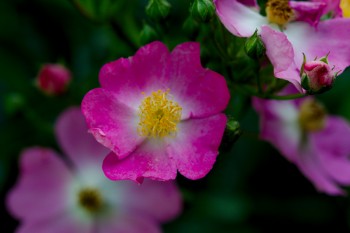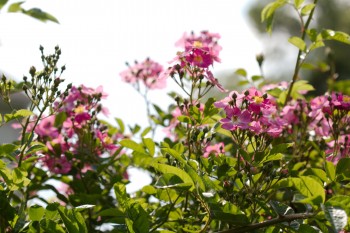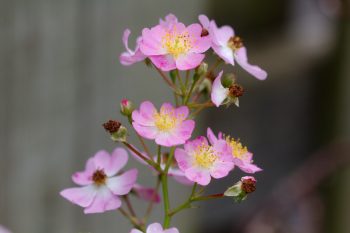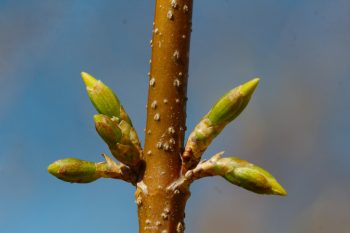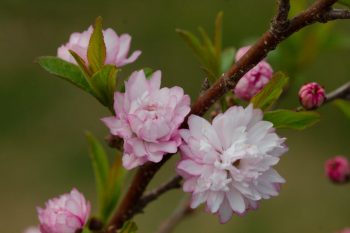We planted this flowering almond when we first moved into the house. It was given to Cathy by a friend. It never gets more than about three feet tall and dies back almost to the ground every other year. Still, when it’s in bloom, it’s pretty nice. And it doesn’t need any pruning.
Tagged With: Flowering Shrubs
Flowering Almond
Multiflora Rose
Last year in my Project 365 I posted a picture of this rose on Day 142, May 22, 2011. I know that you have to be a bit daft to actually plant a multiflora rose, particularly in a small garden. The great English rosarian, Graham Stuart Thomas, says in The Graham Stuart Thomas Rose Book (Sagapress, 1994):
It can best be described as an arching shrub, although its shoots will ramble into trees as high as 20 feet. Normally it makes a dense thicket of interlacing lax shoots, much like a blackberry. So dense is it, indeed, that when planted closely as a hedge it is rabbit-proof, and so thickly do its stems grow that it is becoming increasingly popular in the United States and also in Britain as a roadside plant, for its resilient thicket can hold a car which runs off the road. What a use for a rose! On the other hand, how lucky we are to be able to provide so pretty and sweet a shrub for such a use. It is claimed in America that it is “horse high, bull strong and goat tight.
Thomas, of course, was a rose person. How bad can any rose be? On the other hand, Michael A. Dirr is a more general horticulturalist. He has a little different opinion of R. multiflora in his well respected, 1,187 page Manual of Woody Landscape Plants (Fifth Edition, Stipes Publishing, 1998).
Under the heading “Habit” he says, “A fountain with long, slender, recurving branches; eventually forming an impenetrable tangle of brush suitable only for burning.” About its growth rate he says, “fast; too fast for most farmers who have this species in their fields.” His description for “Culture” is, “Same as described under R. rugosa although this species is more invasive; tolerates dry heavy soils very well.”
He goes on with an entry for “Landscape Value” of “None in the residential landscape; has received a lot of attention for conservation purposes; makes a good place for all the ‘critters’ to hide, yet can be a real nuisance for the birds deposit the seeds in fence rows and open areas, and soon one has a jungle; use this species with the knowledge that none of your gardening friends in the immediate vicinity will ever speak to you again.” Finally, he gives the following “Additional Notes.” “Utilized as an understock for budding the highly domesticated selections. Another species that appears resistant to black-spot and the typical rose diseases. I cannot overemphasize the invasive and greedy nature of this species. Have observed entire pastures/fields invaded and captured by the plant.”
Having said all that, I’m a fan of places for all the critters to hide. Also, this pink sport or more likely a natural hybrid, was growing at the edge of the woods near my office. I dug up a small piece and within a month all that was growing there had been sprayed and killed. Some would argue that I should have let it all be killed but this pink version, which is very similar in almost every way to the species, seemed worth keeping. The difference it in the flowers — they are larger than the species, as well as being a beautiful, dainty pink. There are somewhat fewer of them, but still enough. The leaves seem entirely free of rust, mildew, and black-spot.
Actually, my ultimate goal is to try to produce a tetraploid version of this diploid rose. That would be valuable for hybridizing, because some many important roses are tetraploid. Whether I can actually do that remains to be seen. In the meantime, I’ll continue to prune this hard, trying to keep it contained, and I’ll do it with the knowledge that none of my gardening friends in the immediate vicinity will ever speak to me again.
Pink Rosa multiflora
Another rose photo taken on Monday. Don’t worry, I’m almost out of roses. I posted a few pictures of this rose on May 12 last year along with a fairly lengthy description of R. multiflora. That should be enough of a description to keep anyone from planting this in their garden, but then, this pink version is a little special. Wouldn’t it be nice to get this pink color, along with the well known multiflora resistance to blackspot and incredible vigor, into a repeat flowering rose? That’s my ultimate goal. Not sure what to cross it with, at this point, but I’m thinking. I’d also like to try my hand at creating a tetraploid version of this rose and see what that looks like. Of course, I’ve been meaning to work on that for quite a few years. Some day…
Pink Multiflora Hybrid
The roses are really starting to bloom, finally. This is one that only blooms once during the year but it’s beautiful when it does. It also have very healthy, disease resistant foliage, so it looks pretty good the rest of the year, although it’s just green, of course. This is a found rose and seems to me to be mostly R. multiflora. The wonderful pink flowers, however, speak of some other genes in the mix. I think this rose might contribute to some interesting breeding work and for years I’ve considered it, but so far, haven’t actually done anything.
Rosa multiflora
It’s time for my annual photo of the Rosa multiflora hybrid I have in our back garden. This is a natural hybrid, found growing in the woods near my office. The parent plant is no longer there, because about a month after I dug up a piece it was sprayed and killed. Normally that’s the right thing to do with R. multiflora but this one is special to me, because of the pink blooms that cover the plant this time of year for about a week. It’s quite lovely. It would be even better, of course, if it repeated but one cannot have everything. It’s a vigorous plant, as one would expect with a multiflora hybrid, and handsome as a large patch of green on the back fence, even when not in bloom. It takes a bit of extra care, pruning and cutting out dead wood every couple years, but it’s well worth the effort. That effort is made more difficult by the quantity (large) and quality (also large and very sharp) thorns that absolutely cover the canes. Still, worth it.
Multiflora Buds In The Rain
The rain continued today but I went out briefly to take a few pictures. The large, pink Rosa multiflora (or mostly multiflora, anyway) shrub against our back fence is covered with buds and is just starting to come into bloom. In a few days, and certainly in less than a week, it will be covered with pink flowers. At this point there are only occasional flowers and lots and lots of buds. But in the rain, even that can be pretty, I think. It builds anticipation, if nothing else.
Rosa Multiflora
A few days ago this plant was a mass of buds in the rain. Now the rain has stopped and the buds are opening. Individually the flowers are not really all that amazing, five small, simple, pink petals around a bunch of yellow stamens. In mass they are quite impressive. The entire plant is turning from green to pink and will get pinker before it is done. I picked out one picture to post here and then second guessed myself. I found that I couldn’t decide which one I liked better so I’m posting them both.
Of course, like most rose species, this one only blooms once and then it’s done for the year. It also has very little fragrance. My dream is to cross this with roses that repeat and which have fragrance to get some of the multiflora vigor and disease resistance into a new group of hybrids. Whether that’s ever going to happen is anyone’s guess. Another project, even before crossing it with anything else, is an attempt to double the chromosomes. R. multiflora is, like many rose species, diploid (it has 14 chromosomes). Many hybrid garden roses, including most hybrid teas and floribundas and a lot of the roses I’d cross like to make crosses with, are tetraploid (28 chromosomes). For breeding purposes, a cross between a diploid and a tetraploid is problematic because it produces triploid offspring, which are, with notable exceptions, sterile.
Rosa multiflora
My pink multiflora rose is in full bloom. I suspect it isn’t 100% R. multiflora, because those have white flowers and this is clearly not white. What the rest of its genetic makeup is, I really couldn’t say. R. virginiana would be a reasonable guess. The color is right. The leaves are definitely R. multiflora and it’s got the requisite resistance to black spot. It’s possibly a bit less vigorous, but that’s probably something in its favor. R. multiflora will generally take over and this is large, but fairly well behaved. Pity it only blooms once, but then, the same can be said for the azaleas.
Lilacs
Cathy grew up with parrots in the house. Her father’s family had one when he was young and after they moved back to the states in the 1960s, they had two for many years, Roscoe and Red Head. When Red died, Jim planted these lilacs in his honor and they continue to bloom, year after year. They are a bit leggy, at this point, and could do with a bit of pruning (and a bit more sun, truth be told) but they are still quite beautiful. The only lilac I have in my yard is one grown from seed that I got from The Seed Guild (no longer extant, I believe). It is doing well but has never bloomed. My memory is that it was called a Korean Lilac, but it doesn’t look like Syringa meyeri, which sometimes goes by that name. I’ll have to see if I can find my notes from many (many) years ago.
Rosa rugosa ‘Roseraie De l’Hay’
I’m not sure what happened last year but for some reason, most of my roses died. One of them, a pink flowered R. multiflora hybrid, isn’t quite gone, with one branch left. This R. rugosa named ‘Roseraie De l’Hay’ also has some life left in it. Nevertheless, there’s a fair amount of dead wood to prune out. ‘Blush Noisette’ appears to be completely dead. It was never a very vigorous shrub but for it to simply die completely was unexpected. I lost my ‘New Dawn’ last year, but that I had to dig up because of rose rosette disease, is caused by Emaravirus species of virus.
Korean Lilac
Quite a few years ago, my dad happened to see an ad for something called The Seed Guild. If you bought an annual subscription, they would send seeds collected (with permission) from botanical gardens and arboreta around the world. One of the little packets of seeds that I got were labeled as Korean Lilac. At least that’s my memory. If I have it written down somewhere I certainly don’t know where. I also don’t know if it was Syringa meyeri, which is what is usually referred to as Korean Lilac or if it was some other, lesser known species. In any case, I had it growing in a container for many years and then when we moved here I put it into the ground. The deer ate it back one year but it’s doing pretty well now and for the first time has bloomed. The flowers are quite pale, not the lilac that we think of when we think of lilac. Nevertheless, they are a pretty pink, especially from a distance, where the color is more visible.
Pink Multiflora Rose
Pretty much every year I post a picture of this rose. It’s a multiflora rose (Rosa multiflora) that I collected from the edge of the woods near my office. Shortly after I dug up a piece, the area was sprayed and the mother plant was killed. This has done quite well in the yard until this year. For some reason, this and the rugosa hybrid ‘Roseraie De l’Hay’ nearly died. Another rose, ‘Blush Noisette’, died completely. I also had to remove my ‘New Dawn’ because of rose rosette virus, Happily, there is one old cane as well as another new cane coming up on this shrub, so all is not lost. Here are all my posts with pictures of this rose.
Rose ‘Perle d’Or’
This sweet little polyantha rose is just outside my front door. I’ve posted pictures before but I like this one because it shows the color of the blooms as they open (on the right) and as they age and fade (on the left). They produce considerable fragrance and especially on a warm, humid morning, it’s quite a lovely thing when you come out the door. There is some dead wood on this rose, but no more than normal. It doesn’t seem to have been affected by whatever happened to those in the back. On Saturday, at Nick’s garden, we talked about this rose. He has two of them and one is in almost full, if open, shade, surrounded by hostas. Nevertheless, it continues to bloom quite happily. So, if you have a bright but shady yard and thought you couldn’t grow any roses, you might give this one a try. The flowers are small and not particularly well suited for cutting, but it makes up for that by blooming off and on all summer.
Rose ‘Graham Thomas’
After mom’s brief stay ib the hospital, she had a few follow-up appointments, starting this morning. I thought it would be good to stay with her the rest of the day and because I can work remotely, that’s what I did. I took a short break in the early afternoon and took a few pictures in her yard. I also took some of her neighbor’s roses. This rose is called ‘Graham Thomas’, bred by David Austin, 1983. It is named for Graham Stuart Thomas OBE (April 3, 1909 – April 17, 2003), the famed British botinist, garden designer and rosarian.
Rose of Sharon
When Dorothy was born and we gave her the middle name Rose, a friend gave us a small Rose of Sharon plant. We had that in a container until we moved to our current house and then Cathy planted it in the garden along the south end of our back yard. It has flourished and indeed it is something of a constant chore to pull up the seedlings that appear around the yard, but I will confess that I like the flowers on this large shrub or small tree. They appear over a long period, from early summer well into fall. The Latin name for the plant, Hibiscus syriacus, implies that it comes from Syria, but that appears to be false, being a native of eastern Asia instead.
Forsythia Buds
The forsythia is starting to bud. As I write this, a week after the photo was taken, the buds have opened and the flowers are out. Spring can move quickly at times and when we have a warm spell, as we do at some point most years, buds open quickly. We often then have a frost that can kill back some of the more tender plants a bit. The early flowering star magnolia, with its fleshy, succulent petals, is generally one of the hardest hit. Other plants, like most early bulbs, the Lenten rose, and the forsythia, are better able to cope with a little cold, and generally just stop briefly, only to continue once it warms back up.
Flowering Almond
We have this little flowering almond shrub in our front garden near the corner of our garage. It never gets very big because it’s not entirely hardy here and every couple years it dies back pretty hard. We actually had a few days when the temperature was nearing 0°F (-18°C) but it seems to have come through it practically unscathed. The flowers, clustered around the stems, are fairly small, only a half inch or so across. Never the less, they are quite pretty, both individually and as a whole. It’s really a shame this doesn’t get bigger because it would be spectacular.
Viburnum carlesii
One thing Cathy and I are thankful for is walks in our neighborhood. It’s a relatively quiet neighborhood, especially now, as traffic in the area is considerably lighter than normal. Foot traffic has always been high with a lot of dog walkers and people out for a stroll but that’s increased significantly during the covidian interval. This shrub, Viburnum carlesii, is scattered through the area and right now, you can often smell it before you see it. The fragrance it strong, spicy, and sweet with a hint to me of vanilla. This and Viburnum × burkwoodii, which is cross with V. utile, are among the best viburnums for fragrance (and it’s possible that the one in this photo is the hybrid rather than the species). In fact, Cathy has requested that I plant one in our yard when we’re able to browse the garden centers once more.
Flowering Almond
This is the little flowering almond growing near the corner of our garage. It’s done pretty well the last few years, as we’ve had relatively mild winters but I don’t think it’s ever going to get more than about four feet tall. Maybe it isn’t in the best spot but it’s nice to have when it’s in bloom. There was a bumble bee on it and I tried to get pictures of that but this late in the day it’s in shadow and there just wasn’t enough light to get a sharp enough shot. The flowers are nice by themselves, though.




